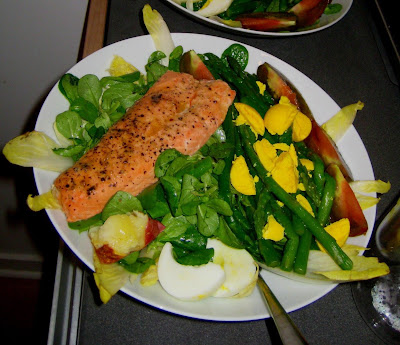 I love getting requests for posts! Most recently I was asked what the differences are between different types of oils and what is best for cooking.
I love getting requests for posts! Most recently I was asked what the differences are between different types of oils and what is best for cooking. To begin, you want most of the fats in your diet to come from polyunsaturated and monounsaturated sources, such as vegetable oils, avocadoes, nuts, seeds, and cold water fish.
Monounsaturated fats lower total cholesterol and low density lipoprotein (LDL) cholesterol (the bad cholesterol) and increase the high density lipoprotein (HDL) cholesterol (the good cholesterol). Polyunsaturated fats also lower total cholesterol and LDL cholesterol.
(Omega-3 fatty acids, which are found in cold water fish, like salmon, as well as in flaxseed and walnuts, belong to this group. Omega-3s as well as unrefined olive oil are also anti-inflammatory and help to prevent chronic disease, such as diabetes and heart disease.)
Smoke point is the temperature to which an oil can be heated before it smokes and discolors, which are indications of decomposition. If you are using an oil with a low smoke point, you'll want to use it in cold preparations, like salads.
For salads, use cold-pressed, unrefined vegetable oils such as sesame, sunflower, safflower, flaxseed, almond, walnut, hazelnut, pumpkin seed, pistachio, avocado, grapeseed, cottonseed, and extra-virgin olive oil (unrefined olive oil has a smoke point of 320°F), among others. Heat would destroy the delicate flavors of these oils.
Safflower oil also doesn't solidify when chilled, which can be useful if you'll be serving a chilled dressed dish.
For cooking, use extra-virgin olive oil, canola oil, peanut oil, refined sesame oil, and refined grapeseed oil, among others. Peanut oil is great for hot woks and Asian stir-fries. Sesame oil comes in a light variety (made from untoasted sesame seeds) and a dark variety (made from toasted sesame seeds). Light sesame oil has a nutty taste and is great for sauteeing or shallow frying in a pan. Dark sesame oil has a very strong flavor and should be used in small quantities for its flavoring.
In Indian food we also sometimes use as a flavoring agent the oil from mustard seeds, which is sharp and a bit spicy.
For frying, corn oil, refined safflower and sunflower oils, and canola oil will do, as they have higher smoke points. (It is best not to fry with olive oil, as its smoke point is only about 190C/375F.)
Fats to avoid (for health reasons -- some of these are quite tasty):
vegetable shortening
margarine
butter
palm oil
palm kernel oil
coconut oil
bacon grease and animal lard
Final notes:
Personally, I hate the smell of soybean oil, so I avoid it.
And the jury is out on coconut oil. Some believe that when consumed raw, coconut oil is beneficial. Choose your own adventure.
For more information, check out the FAQ and the food fats and oils reference on the website of the Institute of Shortening and Edible Oils.







 yield: Makes 8 servings
yield: Makes 8 servings












































